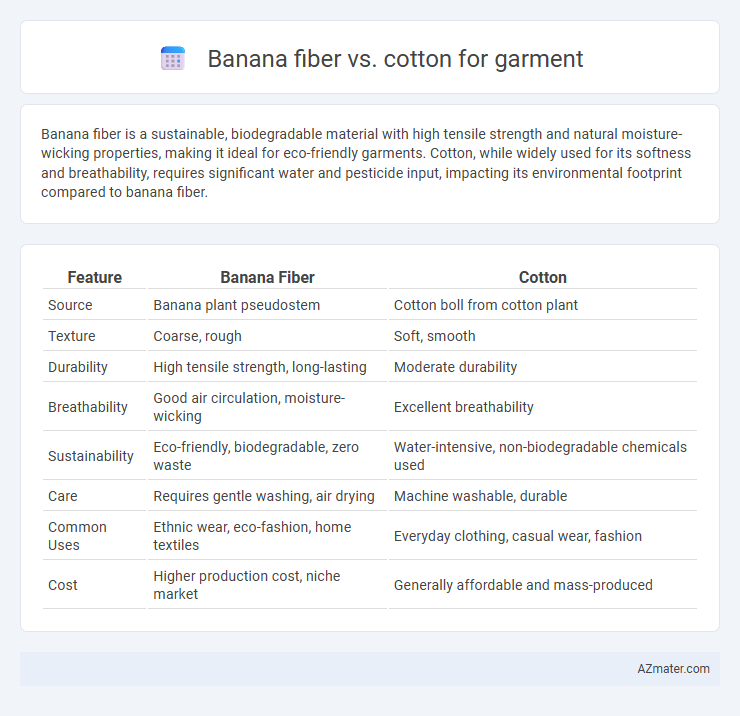Banana fiber is a sustainable, biodegradable material with high tensile strength and natural moisture-wicking properties, making it ideal for eco-friendly garments. Cotton, while widely used for its softness and breathability, requires significant water and pesticide input, impacting its environmental footprint compared to banana fiber.
Table of Comparison
| Feature | Banana Fiber | Cotton |
|---|---|---|
| Source | Banana plant pseudostem | Cotton boll from cotton plant |
| Texture | Coarse, rough | Soft, smooth |
| Durability | High tensile strength, long-lasting | Moderate durability |
| Breathability | Good air circulation, moisture-wicking | Excellent breathability |
| Sustainability | Eco-friendly, biodegradable, zero waste | Water-intensive, non-biodegradable chemicals used |
| Care | Requires gentle washing, air drying | Machine washable, durable |
| Common Uses | Ethnic wear, eco-fashion, home textiles | Everyday clothing, casual wear, fashion |
| Cost | Higher production cost, niche market | Generally affordable and mass-produced |
Introduction to Banana Fiber and Cotton
Banana fiber, derived from the pseudostem of the banana plant, offers a sustainable alternative to conventional textile fibers with natural strength and biodegradability. Cotton, a widely used natural fiber from the seeds of the cotton plant, is prized for its softness, breathability, and widespread availability in the garment industry. Both fibers cater to different eco-friendly and performance-oriented applications, with banana fiber emerging as a strong contender for sustainable fashion.
Origins and Production Processes
Banana fiber is extracted from the pseudostem of banana plants primarily found in tropical regions like India, the Philippines, and Nepal, where the stems are harvested after fruit collection, minimizing waste. Cotton originates from the seed hairs of cotton plants cultivated mainly in the United States, China, and India, requiring extensive irrigation and pesticide use. The banana fiber production process involves stripping, scraping, and washing the fibers, preserving natural cellulose structures, whereas cotton undergoes ginning, carding, and spinning, often involving chemical treatments to achieve softness and durability.
Environmental Impact Comparison
Banana fiber is more sustainable than cotton due to its lower water consumption and ability to degrade quickly without harmful chemicals. Cotton production requires significant pesticide use and intensive irrigation, contributing to soil degradation and water pollution. Utilizing banana fiber in garments reduces environmental strain through its biodegradable nature and the use of agricultural waste, promoting a circular economy in textile manufacturing.
Fiber Properties and Characteristics
Banana fiber, derived from the pseudostem of the banana plant, exhibits high tensile strength, natural antibacterial properties, and moisture-wicking capabilities, making it durable and suitable for eco-friendly garments. Cotton fiber is soft, breathable, and highly absorbent, offering excellent comfort and versatility in textile applications but tends to wrinkle easily and may require chemical treatments for durability. Comparing fiber morphology, banana fibers are coarser with a longer staple length, while cotton fibers are fine and shorter, influencing the texture and drape of the finished fabric.
Comfort and Wearability
Banana fiber offers superior breathability and moisture-wicking properties compared to cotton, enhancing comfort during prolonged wear. Its natural stiffness provides better shape retention, while cotton excels in softness and flexibility, making it more suitable for sensitive skin. Wearability of banana fiber garments benefits from durability and eco-friendliness, whereas cotton garments are widely favored for their ease of care and versatility in various climates.
Durability and Longevity
Banana fiber offers superior durability compared to cotton due to its high tensile strength and resistance to wear, making garments last longer under frequent use. Cotton, while soft and breathable, tends to degrade faster with multiple washes and exposure to sunlight. The natural resilience of banana fiber supports extended garment lifespan, reducing the need for frequent replacements.
Sustainability and Biodegradability
Banana fiber, derived from the pseudostem of banana plants, offers superior sustainability compared to conventional cotton due to its minimal water requirements and natural biodegradability, decomposing within a few months without releasing harmful chemicals. Cotton cultivation demands significant water, pesticides, and synthetic fertilizers, contributing to environmental degradation and longer decomposition timelines in landfills. Choosing banana fiber for garments supports eco-friendly textile production and reduces the ecological footprint associated with fast fashion and non-renewable fibers.
Cost and Market Availability
Banana fiber offers a cost-effective alternative to cotton due to its lower production expenses and faster growth cycle, reducing raw material costs for garments. Cotton dominates global markets with extensive availability and well-established supply chains, making it more accessible for large-scale manufacturing despite higher prices linked to water-intensive cultivation. Market demand for sustainable textiles drives increasing interest in banana fiber, though its limited availability restricts widespread adoption compared to the mass-market presence of cotton.
Applications in the Fashion Industry
Banana fiber offers a sustainable alternative to cotton in garment production, prized for its strength, durability, and natural sheen in eco-friendly fashion. It is increasingly used in accessories, casual wear, and luxury textiles, appealing to brands committed to reducing environmental impact. Cotton remains dominant due to its softness and breathability, but banana fiber's biodegradability and lower water usage make it an innovative choice for sustainable fashion collections.
Future Prospects and Innovations
Banana fiber, derived from the pseudostem of banana plants, offers a sustainable alternative to cotton in garment manufacturing due to its biodegradability and low water consumption. Innovations in banana fiber processing are enhancing its softness and durability, making it more competitive with cotton's comfort and versatility. Future prospects include integrating banana fiber with smart textile technologies and expanding its use in eco-friendly fashion to meet rising consumer demand for sustainable materials.

Infographic: Banana fiber vs Cotton for Garment
 azmater.com
azmater.com